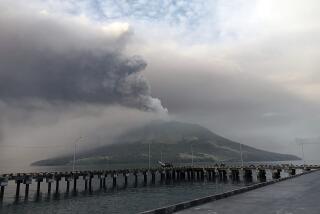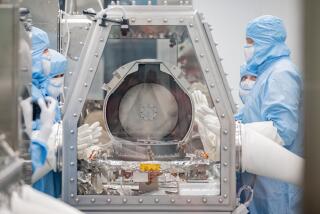Asteroid that killed the dinosaurs had help from volcanoes, study says
Many scientists have long blamed a single culprit in the sudden and violent mass extinction that took out the dinosaurs: an asteroid that came screaming out of the skies some 66 million years ago. But it turns out that this asteroid may have had an accomplice.
Researchers studying ancient lava flows in present-day India have also implicated the volcanic eruptions that they say turned massively deadly around the same time that the asteroid hit – eruptions that, together with the impact, would have filled the air and covered the earth with toxic fumes and dust, driving countless species to extinction.
The findings, described in the journal Science, bind together two long-held theories about what killed off the dinosaurs (and many other species).
“This is pouring gasoline on the debate,” said Henry Melosh, a planetary scientist at Purdue University who was not involved in the paper.
The Deccan Traps in India feature layers upon layers of volcanic rock and are the long-solidified remains of one of the world’s truly enormous volcanic eruptions.
The amount of lava extruded “would correspond to something like half a million cubic kilometers,” said lead author Paul Renne, a geochronologist at the Berkeley Geochronology Center. “It’s enough to cover the entire Earth to a depth of something like a meter or so. It’s really big.”
Some researchers have argued that it was this massive event that actually killed off the dinosaurs; others have said the volcanoes had little impact compared with the asteroid. But Renne and his colleagues wondered if the two were related; after all, having such massive volcanic flows around the same time as a devastating asteroid impact seemed like an unlikely coincidence.
So the researchers traveled to India to the Deccan traps, where lava flows piled high reach about 3,000 meters in thickness, Renne said. There, they sampled different levels of volcanic rock (the lower ones are older, and higher ones are younger, giving the scientists a layer-by-layer look through time). They wanted to see if any changes with the rock coincided with the asteroid impact.
“What we wanted to do was sample from the bottom of the pile, the middle of the pile and the top of the pile -- and try and determine where, within that whole sequence, the age of the impact and the extinction occurs,” Renne said.
The volcanoes had been erupting before the asteroid’s arrival, but the researchers focused on a clear transition point where the pattern of the lava flows seems to have dramatically changed. Before this transition, the magma welling up from the mantle showed clear evidence of having mixed with stuff in the crust – probably because it was hanging out in many small chambers before fully erupting, giving the magma a lot of surface area to interact with the crust.
But at a certain point, this pattern dramatically changed. The lava layers laid down after this point appear relatively “pure,” with fewer signs of crustal interaction, which shows that they were probably held in a giant reservoir instead of many small ones. The volcanic rock also has a different composition from earlier layers – some of the rock must have crystallized and fallen out of the magma before it erupted. That means that the lava collected in that enormous reservoir long enough for this crystallization to occur.
“That looks like a fundamental change in the plumbing system,” Renne said.
Such a change in the nature of eruptions -- from frequent but small to occasional but enormous -- could have been brought on by the shock of the asteroid impact, he said. And sure enough, after dating the rock samples, they were able to show that this change occurred within roughly 50,000 years of the asteroid’s arrival – which bolsters the case that the two were related.
These eruptions could have suppressed the recovery of species for roughly 500,000 years, the researchers said.
The findings don’t directly prove that the two events were linked – and the scientists are working on narrowing that window down from 50,000 to perhaps 5,000 years. But the findings still offer compelling circumstantial evidence, Renne said.
“It should hopefully inspire people not to try and bolster one or the other of the two hypotheses and quit saying, ‘Well it was all impact and the volcanism had nothing to do with it,’” Renne said. “We really have to look at the two of these processes more organically than before.”
But Melosh, who praised the technical aspects of the work, said he remains unpersuaded, pointing out that no causal connection had been made between the two. The extinction event appears to have been sudden, rather than gradual, which matches better with an asteroid than long-lived vulcanism, he added.
“I don’t think this is going to settle any debate,” Melosh said. “In fact, I think it will probably warm it up a bit. “
Love dinosaurs? Follow @aminawrite for more science news from the Lost World
MORE FROM SCIENCE:
Scientists identify potential birth control ‘pill’ for men
British sites yield mummies, but no King Tuts as found in Egypt
Can drastically reduced nicotine take the ‘hook’ out of cigarettes?







